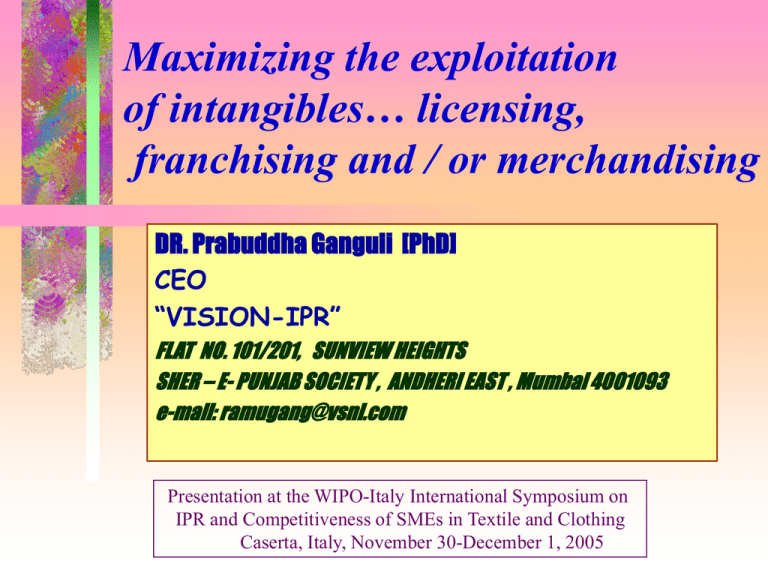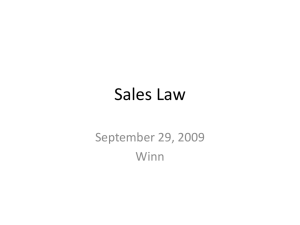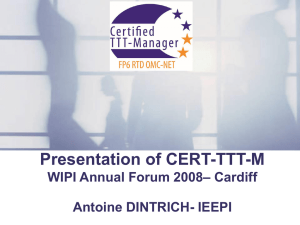PPT
advertisement

Maximizing the exploitation of intangibles… licensing, franchising and / or merchandising DR. Prabuddha Ganguli [PhD] CEO “VISION-IPR” FLAT NO. 101/201, SUNVIEW HEIGHTS SHER – E- PUNJAB SOCIETY , ANDHERI EAST , Mumbai 4001093 e-mail: ramugang@vsnl.com Presentation at the WIPO-Italy International Symposium on IPR and Competitiveness of SMEs in Textile and Clothing Caserta, Italy, November 30-December 1, 2005 Multiple uses Design Cost Quality Availability Meeting standards pganguli©2005 Innovation and its protection as integral part of Business Strategy An absolute imperative…………. pganguli©2004 pganguli©2005 Intellectual Creations Take ownership to convert them into your property Therefore get your rights to them To exploit them as your assets USE YOUR INTELLECTUAL PROPERTY RIGHTS p.ganguli©2005 Exploiting IP Business Tools • Logo(s) TM/Copyright • Words and their combinations TM/Copyright • Sound TM/Copyright • Ornamentation, Shape, Form Copyright/TM/Design Registration • Functionality Patents • Geographical Place of Origin GI • Know How Confidentiality/Trade Secrets pganguli©2005 Various aspects of IPR Create Products / Services Convert to property by claiming ownership Introduce into the market and / or Transfer / sell the rights to other persons or enterprises Earn royalty/ earn price for selling the rights Strategically Share MARKETS Enforce rights pganguli©2005 Patent Number 924284 Design Number 359633 Utility Model Number 1428858 Trademark Number 1183902 U.S.A, Canada, UK, Germany, Holland, France, Spain, Italy, Sweden, Norway, Iran, Mexico, Chili, Argentina, Taipei, The Philippines, Hong Kong, Source: Slide Presented by Mr Yuji Okuma of JPO at the WIPO Workshop, Guangzhou, China July 10-12, 2002 pganguli©2005 IPR Portfolio Building Seed, nurture, cultivate and harvest Innovation to create the Present, Immediate Future and distant future portfolios Measuring IP Performance STRATEGIC ELEMENTS What is the nature of protection offered by the diverse IPR tools? 1. Do we have to protect our IPR in every country in which we wish to do business? 2. When do I have to license / assign any IPR? 3. What is the period of VALIDITY of the IPR tools 4. Are enforcement features uniform across the world? 5. What do I assign? what do I license? What do I keep as trade secret / know how? How do I keep my business interest in selected territories? A clear appreciation of these…. Imperative for all IPR players pganguli©2005 Paths to IP Exploitation • • • • Delivery of Know-how Contract Research and Development Establishing Joint Ventures Setting up Plants, establishing production processes, quality control procedures, etc. on a turnkey basis • Licensing patents, designs and other forms of IPR • Franchising • Collaborative R&D pganguli©2005 A basket of Legal Frameworks to be considered in IP Exploitation • • • • Contract law Patent Law Trademarks. GI, Copyrights and Design Law Law relating to restrictive and unfair trade practices • International laws • Tax and revenue related laws Note: This is not an exhaustive list pganguli©2005 Group Exploitation of IP…. options • Trademarks Certification Marks Collective Trademarks • Geographical Indications • Copyright Societies • Pooling for essential patents pganguli©2005 How does one realise the value of one’s intellectual assets A structured audit is necessary Managing IPR … Market Phase pganguli©2005 Some Options for the IP proprietor • Use the IP … manufacture the product, use the process, sell by self or by contracting it to another party. • License it to someone for manufacturing but market the product by self or by contracting it to another party. • Sell the IP • Set-up a Joint venture • Source of one-time or steady long term income from the license fees/royalties • Negotiate License for manufacture by and /or marketing with geographical breakup of the markets. pganguli©2005 Some Options available to the IPR Holder • License the IPR to another party (s) with mutually negotiated benefit sharing arrangements • Cross License for mutually independent working and / or collaborative working • Assign the IPR to another party (s) for an appropriate return • Barter rights • Establish a franchise system involving other parties • Take action against those who infringe the IP • Let the rights selectively lapse in certain countries pganguli©2005 Options available to the IPR Holder • License the IPR to another party (s) with mutually negotiated benefit sharing arrangements • Cross License for mutually independent working and / or collaborative working • Assign the IPR to another party (s) for an appropriate return • Barter rights • Establish a franchise system involving other parties • Take action against those who infringe his rights • Let the rights selectively lapse in certain countries pganguli©2005 Patent Strategies • Effective use of International Conventions • Strategic options in the statutory provisions e.g. divisional applications, continuation, and continuation in part • Extending life of an invention …variants • Joint patents • Patent Leveraging • Litigation as a strategy pganguli©2005 New IPR Management Approaches • The 3 G Platform … an approach to cooperative licensing • DVD Consortium… setting up one stop shop for licences. • Intellectual Capital Management (ICM) e.g. Dow Chemicals • Gene Bank Consortiums pganguli©2005 Licensing Agreement A reflection of Complimentary Needs satisfied by a formal contract that appropriately and equitably addresses the mutual requirements within a framework that is enforceable within specified legal frameworks Why license out • Access to foreign markets – Enter a foreign market without being concerned with setting up operations, dealing with foreign regulations and customs, test the market from a distance, access to low cost labor • Stick license (make an ally of an infringer) • Create standard - the more the technology is used the more likely it could become an industry standard pganguli©2005 Why NOT license-out • Create competitor • Lose control of proprietary information • The risk of partnering with a “bad” licensee and risking revenue and the reputation of your product pganguli©2005 The aim of a licensing agreement is : • To put the licensee in possession of the technology needed to manufacture the licensed products • to derive an economic return from this activity • to share this return with the licensor pganguli©2005 Licence Agreements • What is being licensed • What are the rights of parties involved in the deal • What are the financial and commercial aspects of the licensing arrangements • What is the term of the licence? • Other aspects of the agreement such as confidentiality • Who will own the rights to further developments by the licensee. • Will the licenser transfer further developments to the licensee as part of this agreement. Or what will be the arrangement. pganguli©2005 Licence Agreements.. Key issues • • • • • • • • • • • pganguli©2005 The rights… make, use sell ? Geographical jurisdiction of the rights Exclusive or non-exclusive Rights to sub-licence by the licensee? Rights to the improvements? Term of the agreement Are there any minimum time limits set for the licensee to put the licence into practice? If such time restrictions are not met, what are the consequences? Clauses that will survive beyond the term of the agreement Any anti-competitive practices have been built in the agreement? Rights to conduct parallel imports? What will happen if the technology licensed under this agreement becomes a subject of compulsory licence in a country? Licence Agreements.. Key issues • Who will be responsible for the renewal of the IPR associated with the technologies covered in the licence agreement? Who will bear the costs for such transactions? • Who will be responsible for any disputes arising with respect to the IPR associated with the licence agreement? • Who will bear the legal costs of the disputes arising out of the IPR associated with the licence agreement? • What will be the impact on the commercial terms and the rights acquired if the IPR associated with the licence agreement get invalidated? • What will be the impact on the royalty payments if the disputes related to the IPR are settled in favour or against the owner of the IPR associated with the licensing agreement? • What happens if the licensee files for bankruptcy, insolvency, pganguli©2005 Licensing Agreements • • • • • • • • Access to information Dispute resolution Applicability of law and jurisdiction Expiry and termination Notices Liabilities Penalty Clauses Any previous securities and pledges of either parties involved in the licence agreement • Financial and commercial obligations • Transmission of the rights and obligations to affiliated companies, present and future associates through mergers and acquisitions, legal heirs, employees, etc. • Options for future amendments to the licensing agreement pganguli©2005 Issues post licensing.. •Licensees may take actions that have an adverse impact on the licensor's ability to get return on his R&D investments (e.g. poor quality control, overstepping territorial restrictions, revelation of private information, etc.) • May also "invent around" and develop innovations that will limit the licensor's ability to valorize his patents. • After the agreement is signed, the licensor may withhold necessary technical and marketing support for the licensee to effectively integrate the technology pganguli©2005 Opportunistic behavior • contractual problems may arise – – because of the parties’ risk aversion uncertainty concerning the value of the technology that is licensed – licensees do not know ex-ante the value of the technology, they can be reluctant to pay in advance for it. When it is transferred, they can refuse to pay for the information that has been transferred to them. pganguli©2005 Franchising How is this different from licensing? Franchising • Giving rights to one or more parties to conduct commercial activities as per laid down business practices, code of work, meeting quality standards in raw materials and finished products simultaneously allowing the franchisee to use the trademark, service mark, patents, trade secrets, copyright, design registration, etc. all this for an appropriate return. E.g. McDonalds, Pizza Hut, etc. pganguli©2005 Key features …. Franchising http://www.allbusiness.com/ 1. Training and/or ongoing support provided by the franchisor. Each franchisor has its own training program for franchisees and their staff, which can include training done at the franchisee's location or at the corporate headquarters or a combination. Most franchisors offer ongoing support including administrative and technical support. 2. Assigned territory. Your franchise Agreement will designate the territory in which you will operate and whether or not you have exclusivity rights. 3. Duration of the franchise agreement. This provision states the length of the agreement. 4. Franchise fee and total anticipated investment. Franchisees are required to pay an initial franchise fee that grants them the right to pganguli©2005 Key features …. Franchising http://www.allbusiness.com/ 5. Trademark, patent and signage use. This provision covers how a franchisee can use the franchisor's trademark, patent and signage. 6. Royalties and other fees you are expected to pay. Most franchisors require franchisees to pay an ongoing royalty, usually 4-8 percent of total sales, typically on a monthly basis. 7. Advertising. The franchisor will reveal its advertising commitment and what fees franchisees are required to pay towards those costs. 8. Operating protocol. This section details how franchisees run their outlets. pganguli©2005 Key features …. franchising http://www.allbusiness.com/ 9. Renewal Rights and franchisee termination/cancellation policies. These provisions deal with how the franchise can be renewed or terminate Some franchisors have an Arbitration Clause in the Franchise Agreement, which means that if legal actio on either side is warranted, an arbitrator will review the case instead of going to court. 10. Resale rights. Some franchisors allow franchisees to sell their franchises for whatever reason. Many, however, write in buy back or right of first refusa clauses, which allow the franchisor to buy back the franchise at a rate determined by them or to match any potential buyer's offer who has expressed interest in buying your franchise. pganguli©2005




